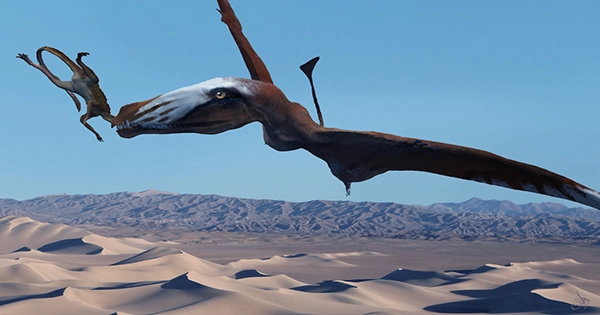Student Amelia Penny discovered the fanged jaws of the largest Jurassic pterosaur known to science jutting out of a rock on the Isle of Skye, Scotland, in 2017. The team behind the find has been investigating the incredible fossil at the University of Edinburgh after battling the tides to recover it with diamond-tipped saws. The terrifying, fanged, and the winged specimen has been detailed in a report published in Current Biology, which describes both the splendor of the three-dimensionally preserved fossil and the significance of this new species in our understanding of Jurassic pterosaurs.
Dear sgiathanach (pronounced jark ski-an-ach) is a Scottish Gaelic name that means “winged reptile” and “reptile from Skye,” and it pays honor to the Isle of Skye where it was discovered. It is thought to have had a wingspan of nearly 2.5 meters and was the largest pterosaur of the Jurassic period known to science (over eight feet). Despite its enormous size, D. sgiathanach appears to be far from finished. It was a juvenile-subadult and not quite fully grown when it died, according to the growth rings inside its bones.
D. sgiathanach, a toothy predator, would have spent its days scooping enormous fish and squid out of the warm waters of Scotland, which was closer in climate to the Canary Islands at the time. Its massive fangs, which could easily puncture and hold onto prey, reflect its habit of snatching creatures from the water. What D. sgiathanach can teach us about pterosaurs, in general, is that these flying reptiles grew to be much larger than previously thought. It was previously thought that they were fairly little from the Triassic to the Jurassic, before supersizing in the Cretaceous alongside a varied range of birds.
However, it now appears that the hypothesis of pterosaur size plateauing until the Cretaceous is incorrect and that significant evolution was occurring among pterosaurs as early as the Middle Jurassic. The study authors noted, “There were rather large pterosaurs in the Jurassic (wingspans > 1.8 m), but relatively complete adult or near-mature skeletons are generally lacking, for reasons obscure and deserving of further investigation.”
“The Middle Jurassic age of Dear adds to mounting evidence that this interval—once a disappointing gap in the pterosaur record—was in fact a vibrant period of diversity,” says the author. “Like dinosaurs and mammals, the Middle Jurassic was most likely a dynamic period in pterosaur evolution, rather than a stagnant and archaic forerunner to a Cretaceous boom of larger, more diverse, and more efficient fliers.”
















